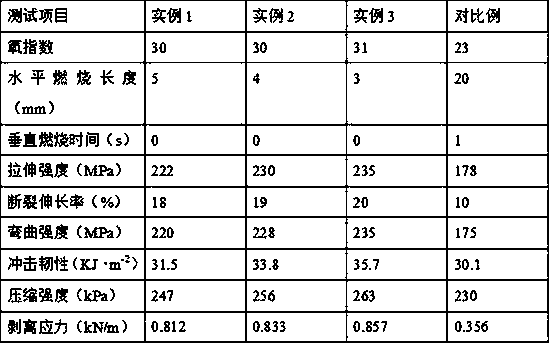Preparation method of flame-retardant foam composite board
A fire-retardant foam and composite board technology, applied in the preparation of animal glue or gelatin, the joining of wooden veneers, chemical instruments and methods, etc., can solve the problems of easy peeling, weak bonding ability, easy detachment, etc. To achieve the effect of improving thermal stability and reducing heat
- Summary
- Abstract
- Description
- Claims
- Application Information
AI Technical Summary
Problems solved by technology
Method used
Image
Examples
example 1
[0027] Add 200 mL of distilled water to a four-necked flask with a stirrer and a reflux condenser, adjust the pH to 9 with a 40% sodium hydroxide solution, heat the four-necked flask to 90°C, add 60 g of soybean flour, and heat preservation. After 50 min, add 10 g of phenol to the four-necked flask, cool down to 70 °C, keep heat for 15 min, continue to add 20 mL of formaldehyde solution with a mass fraction of 40% into the four-necked flask, react for 1 h, and naturally cool to room temperature to obtain modified soybean protein Adhesive; put poplar wood into a wood pulverizer and pulverize for 4 hours, pass through a 200-mesh sieve to obtain poplar wood powder, mix 20 g poplar wood powder, 70 g bamboo fiber, and 100 mL of water to obtain bamboo fiber pulp, and inject the bamboo fiber pulp into a vacuum In the forming tank of the dehydration device, after air bubbling and stirring for 10s, stand for vacuum dehydration for 5min, and the vacuum degree during dehydration is contro...
example 2
[0029] Add 210 mL of distilled water to a four-necked flask with a stirrer and a reflux condenser, adjust the pH to 9 with a 40% sodium hydroxide solution, heat the four-necked flask to 95°C, add 65 g of soybean flour, and heat preservation. After 53 minutes, 11 g of phenol was added to the four-necked flask, the temperature was lowered to 73°C, and the temperature was maintained for 17 minutes. Then 22 mL of formaldehyde solution with a mass fraction of 40% was added to the four-necked flask, reacted for 1.5 hours, and naturally cooled to room temperature to obtain modified soybeans. Protein adhesive; put poplar wood in a wood pulverizer and pulverize for 4.5 hours, pass through a 200-mesh sieve to obtain poplar wood powder, mix 25 g of poplar wood powder, 73 g of bamboo fiber, and 110 mL of water to obtain bamboo fiber pulp, and inject the bamboo fiber pulp into the belt In a molding tank with a vacuum dehydration device, after air bubbling and stirring for 13s, stand for vac...
example 3
[0031] Add 220 mL of distilled water to a four-necked flask with a stirrer and a reflux condenser, adjust the pH to 10 with a 40% sodium hydroxide solution, heat the four-necked flask to 100 °C, add 70 g of soybean powder, and heat preservation. After 55min, add 12g of phenol to the four-necked flask, cool down to 75°C, keep heat for 20min, continue to add 25mL of formaldehyde solution with a mass fraction of 40% into the four-necked flask, react for 2h, and naturally cool to room temperature to obtain modified soybean protein Adhesive; put poplar wood in a wood pulverizer and pulverize for 5 hours, pass through a 200-mesh sieve to obtain poplar wood powder, mix 30 g poplar wood powder, 75 g bamboo fiber, and 120 mL of water to obtain bamboo fiber pulp, and inject the bamboo fiber pulp into a vacuum In the forming tank of the dehydration device, after air bubbling and stirring for 15s, stand for vacuum dehydration for 8min, and the vacuum degree during dehydration is controlled...
PUM
 Login to View More
Login to View More Abstract
Description
Claims
Application Information
 Login to View More
Login to View More - R&D
- Intellectual Property
- Life Sciences
- Materials
- Tech Scout
- Unparalleled Data Quality
- Higher Quality Content
- 60% Fewer Hallucinations
Browse by: Latest US Patents, China's latest patents, Technical Efficacy Thesaurus, Application Domain, Technology Topic, Popular Technical Reports.
© 2025 PatSnap. All rights reserved.Legal|Privacy policy|Modern Slavery Act Transparency Statement|Sitemap|About US| Contact US: help@patsnap.com

